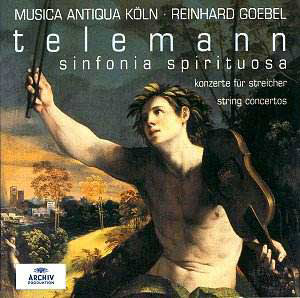Telemann is one of those composers who produced such
an overwhelming quantity of work that it is very hard to overcome
the perception of him as a hack. This recording, however, as with the
others by these musicians, is the ideal way of doing so. The performances
are full of vigour, imagination and humour. There’s nothing polite about
them, and as a result, the music comes up fresh as a daisy, and full
of quirks, too. It put me in mind of the crazy world of Zelenka, so
many oddities and surprises are there. Another feature of the music
is its lack of padding; very often Telemann simply stops rather than
extend the music for another minute or two. This can be disconcertingly
abrupt, but on the whole represents an attitude of which I approve,
i.e. when you’ve said what you have to say, stop. Not all Baroque composers
are like this (nor indeed are some more recent ones!).
The very first track, the first movement of the Sinfonia
Spirituosa in D, exemplifies the ensemble’s virtues under Reinhard
Goebel’s direction. Rhythms have a springy, almost folk-dance feeling
to them, and the music has a wonderful swing. In the Largo, the
group produces a rich, euphonious sound, while the final Vivace simply
buzzes along. The Overture in D that follows features a prominent gamba
part, played with panache by Jaap ter Linden. Listen too to the deep
plucked sound of the theorbo, a bass lute, in the beautiful Sarabande,
another delightful touch.
The three pieces for violin quartet included on the
disc – a sonata and two concertos – bring some of Telemann’s most harmonically
daring music. The textures are endlessly varied and resourceful too;
listen to the Grave of the sonata, with its strange dry accompaniment
to the sustained upper lines, or the rustling semiquavers of the Allegro
that succeeds it.
The most idiosyncratic pieces on the disc are the last
orchestral concerto and symphony. The concerto is titled ‘Die Relinge’,
being the German, apparently, for a peculiarly slothful type of
toad, which spends the spring and summer sitting in stagnant puddles.
Not an especially poetic image for the title of a work, and of course
this may well have been an in-joke of some kind between Telemann and
his players or employers (similar to Haydn’s in the Farewell Symphony
for example). On the other hand, the first movement does contain,
after a normal enough start, some quite extraordinary passages based
on endless repeated notes, with some very strange twists in the harmony.
The oddest piece of all, though, is the final Symphony,
written for the centenary of the Hamburg trade delegation. The three
movements are entitled ‘The Old World’, ‘The Middle [or Middle-aged?]
World’, and ‘The Young World’, and the extreme brevity of the movements
suggests that this was a commission that the composer didn’t take terribly
seriously. The old world is represented by a hideously lumbering movement,
marked ‘Altdeutsch - ernsthaft – munter’ – old German, earnest, merry.
Not sure about the ‘merry’! The middle world takes the form of a short
movement in ‘Capellmässig’, (church style), while the finale is
a short lively dance movement. All very strange, but lots of fun in
these intelligent performances.
The sound that this ensemble produces is wondrous to
hear; it’s partly the tuning, which is so extraordinarily ‘spot-on’
that you feel you’ve never heard a D major chord, for example, quite
perfectly in tune in your life before. And the recording captures it
all superbly – close and intimate, but not artificial. Treat yourself
to this – you’ll be very glad you did!
Gwyn Parry-Jones


